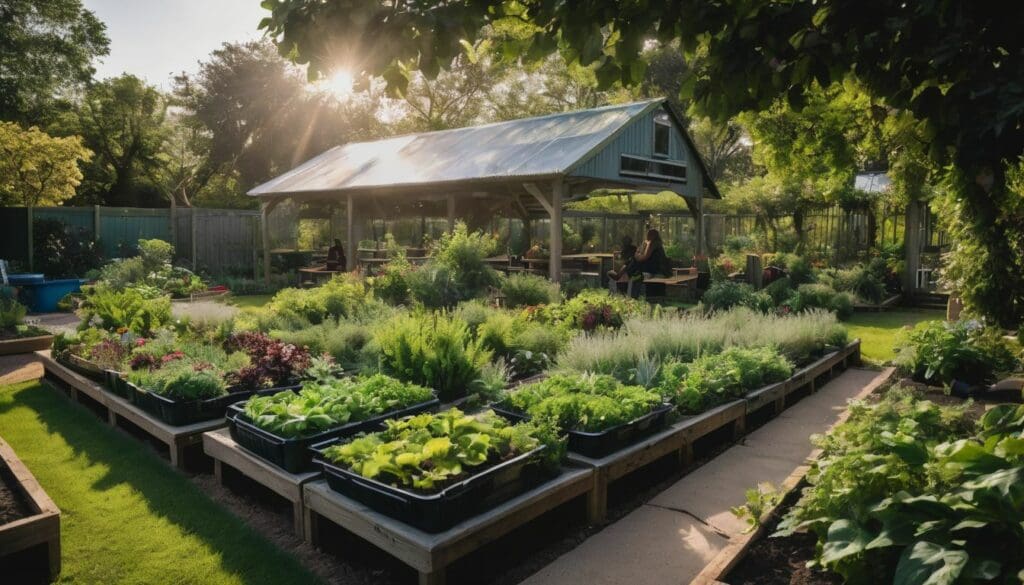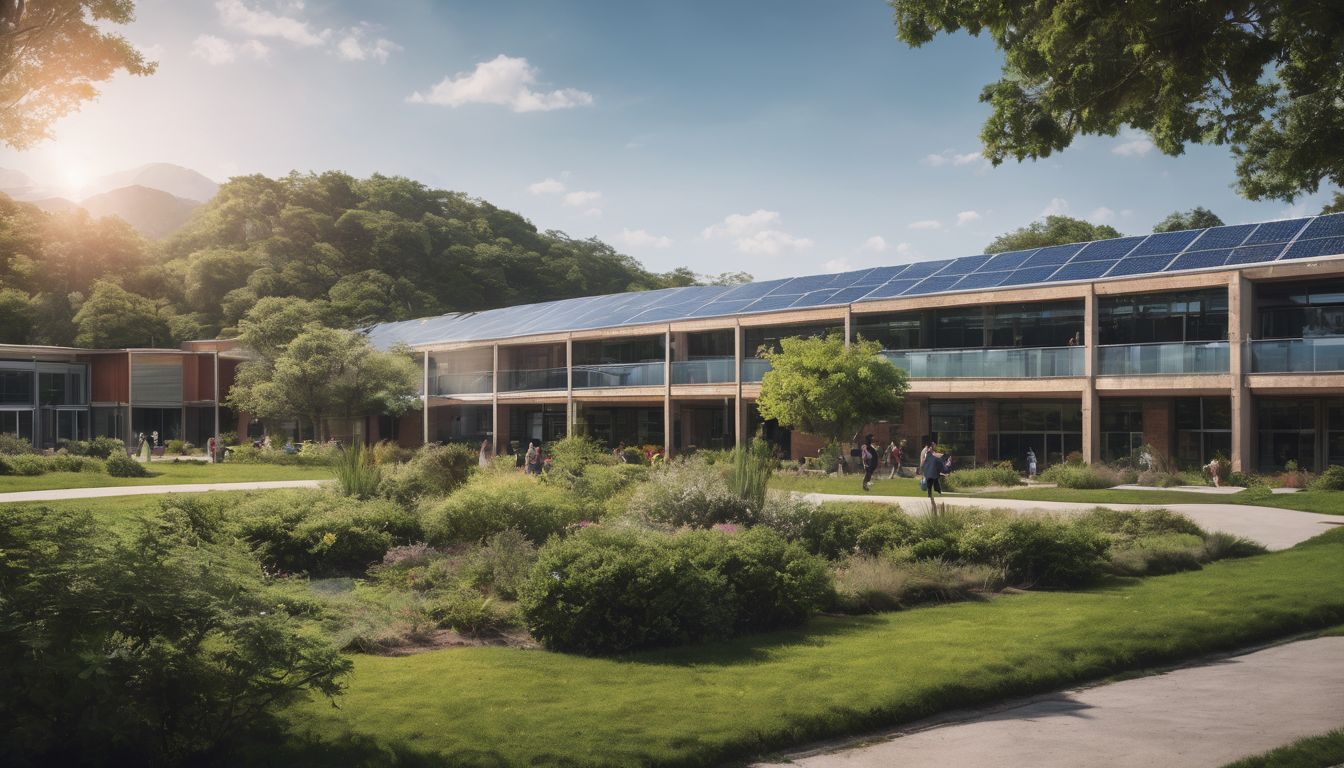The quest for healthier, more sustainable schools is gaining momentum across the globe. Studies have shown that green schools can boost student and teacher wellbeing substantially.
This article explores how embracing green design and policies enhance health in educational settings, keeping our kids both smart and well. Dive into a world of eco-friendly learning!
Key Takeaways
- Green schools with natural lighting and clean air systems help students achieve better grades by improving focus and reducing cognitive distractions.
- Features like ergonomic furniture, gardens, and outdoor play areas in green schools encourage students to be more active, leading to better physical health.
- With detailed wellness policies, green schools provide guidelines on healthy eating, regular exercise, and mental health support for a well-rounded educational experience.
- Sustainable materials used in the construction of green schools reduce exposure to harmful chemicals ensuring a safer environment conducive to learning and wellbeing.
- Practical measures such as hand washing campaigns and sourcing organic local produce are implemented by green schools to foster healthy habits among their communities.
Benefits of Green Schools for Health and Wellbeing
Green schools have been shown to improve academic performance, reduce stress and fatigue in students, encourage physical activity, and promote healthy habits. These benefits contribute to the overall health and wellbeing of students and staff.
https://www.youtube.com/watch?v=VoI6tkeEj9M
Improved academic performance
Students thrive in green schools, showing marked improvements in their academic performance. Naturally lit classrooms enhance focus and energise the mind, leading to higher test scores and better grades.
Environmentally-friendly building designs often incorporate features that stimulate learning, such as clean air systems that reduce drowsiness and cognitive distractions.
With sustainability integrated into the curriculum, students develop an understanding of environmental stewardship alongside math and literacy skills. This dual focus prepares them for a future where ecofriendly practices are essential.
Moving from academics to mental wellbeing, green schools also tackle stress levels with spaces designed for tranquillity and reflection.
Reduced stress and fatigue
Green schools contribute to reduced stress and fatigue among students and teachers. The incorporation of natural light, indoor plants, and green spaces creates a calming environment.
These schools also prioritise proper ventilation and air quality, ensuring a healthy atmosphere that supports mental well-being. Furthermore, green schools often incorporate ergonomic design principles which can help reduce physical strain and promote better posture in both students and teachers.
The emphasis on sustainable practices not only benefits the environment but also fosters an environment conducive to reducing stress levels through exposure to nature. In addition, eco-friendly features like insulated windows or noise reduction materials can create a quieter learning space which further aids in minimising stress for everyone involved.KEYWORDS: Ecofriendly schools, Mental health support, Green building design.
Encourages physical activity
Promoting physical activity in green schools is vital for the overall health and wellbeing of students. Incorporating open outdoor spaces, such as gardens or playgrounds, encourages students to engage in active play and exercise during school hours.
Designing classrooms with adjustable standing desks and ergonomic furniture also promotes movement and reduces sedentary behaviour among students, contributing to a healthier school environment.
Furthermore, integrating physical education into the curriculum offers structured opportunities for students to participate in organised sports and fitness activities. Providing access to facilities like gymnasiums or sports fields supports the development of an active lifestyle while reinforcing the importance of regular exercise for physical health.
Promotes healthy habits
Encouraging physical activity is just one way that green schools promote healthy habits. By integrating wellness into the school environment, students are encouraged to make positive choices for their overall health and well-being.
This includes access to nutritious food options, promoting hand washing and hygiene practices, as well as incorporating wellness education into the curriculum. Green schools play a crucial role in nurturing healthy living habits among students by creating an environment that supports sustainable living and encourages physical fitness.
In addition to fostering a more resilient and healthier learning environment, promoting healthy habits within green schools also contributes to the development of environmentally conscious individuals who understand the significance of personal health in relation to environmental impacts.
Incorporating Wellbeing into Green School Design
Green school design incorporates access to nature, sustainable materials, and proper ventilation to promote health and wellbeing.
To learn more about the importance of promoting health and wellness in green schools, continue reading.
Access to nature and outdoor spaces
Green schools provide ample access to nature and outdoor spaces, contributing to a healthier environment for students and staff. This fosters a connection with the natural world and encourages physical activity. It also offers opportunities for hands-on learning experiences, promotes mental wellness, and provides areas for relaxation and stress reduction. Moreover, exposure to green spaces has been linked to improved cognitive function, attention restoration, and reduced symptoms of attention deficit disorder (ADD) in children.
- Nature trails, gardens, and outdoor classrooms offer opportunities for experiential learning and promote environmental appreciation.
- Green roofs or living walls contribute to biodiversity, reduce urban heat island effects, improve air quality, and provide insulation.
- Courtyards and green play areas create inviting spaces for students to engage in physical activities while surrounded by nature.
- Water features such as fountains or ponds not only enhance the aesthetic appeal but also provide calming effects that contribute to overall well-being.
- Outdoor seating areas offer students and teachers peaceful places for relaxation during breaks or after school hours without excluding themselves from nature’s influence.
Sustainable and non-toxic materials
Green schools prioritise the use of sustainable and non-toxic materials to create a healthy environment for students and staff. This approach involves:
- Utilising renewable and eco – friendly building materials to reduce environmental impact.
- Incorporating non – toxic paints, sealants, and adhesives to maintain indoor air quality and promote environmental health.
- Implementing flooring and furniture made from recycled or sustainably sourced materials to support green living habits.
- Installing energy – efficient lighting systems that contribute to the overall wellness of the school community.
- Choosing low – emission insulation and soundproofing materials to enhance the learning environment while prioritising equity in education.
- Employing water – efficient fixtures and fittings to promote responsible water usage and sustainability practices.
Proper ventilation and air quality
Green schools prioritise proper ventilation and air quality to ensure a healthy indoor environment. Good ventilation reduces the concentration of indoor air pollutants, such as volatile organic compounds (VOCs) and carbon dioxide, promoting better respiratory health for students and staff.
By incorporating natural ventilation strategies and efficient filtration systems, green schools maintain high indoor air quality levels conducive to learning and overall wellbeing.
Sustainable building materials further contribute to creating a healthier school environment by reducing exposure to harmful chemicals found in traditional construction materials. Non-toxic building materials safeguard against off-gassing of harmful substances, supporting the physical health initiatives promoted within green schools.
Implementing Wellness Policies in Green Schools
Green schools can implement wellness policies by prioritising low-cost measures, encouraging healthier food choices, and promoting hand washing and hygiene. These policies can significantly contribute to the overall health and wellbeing of students and staff.
Prioritising low-cost measures
Prioritising low-cost measures is essential for promoting health and wellness in green schools. It can be achieved through simple yet effective strategies:
- Installing water refill stations to encourage hydration and reduce plastic waste.
- Incorporating natural lighting to reduce energy costs and promote a healthier learning environment.
- Creating school gardens to teach sustainability and provide fresh produce for nutrition education.
Encouraging healthier food choices
Encouraging healthier food choices is vital in promoting health and wellness in green schools. It involves providing nutritious meal options, educating students on the importance of balanced diets, and involving the school community in cultivating sustainable food practices.
- Offering a variety of fresh fruits and vegetables to promote better nutrition.
- Collaborating with local farmers to source organic produce for school meals.
- Educating students about the benefits of healthy eating through interactive workshops and cooking classes.
- Integrating sustainable gardening programs to teach students about growing their own food.
- Involving the school community in initiatives such as composting and reducing food waste to instill responsible food consumption habits.
- Establishing partnerships with local businesses that support ethical and sustainable food production practices.
Promoting hand washing and hygiene
- Installing hand sanitising stations in key locations around the school, such as entrances, cafeterias, and classrooms, to promote regular hand sanitisation.
- Educating pupils about the importance of proper hand washing techniques and providing easy access to soap and water in all restrooms.
- Implementing regular cleaning schedules for shared surfaces and equipment to reduce the risk of spreading germs.
- Organising educational workshops on the importance of hand hygiene and its impact on overall health.
- Encouraging pupils to take responsibility for their personal hygiene by providing individual hand sanitiser bottles or wipes for use throughout the day.
Successful Examples of Green Schools Promoting Health and Wellbeing
One successful example is the implementation of detailed wellness policies in green schools, which outline specific measures to promote health and wellbeing for students and staff.
Another example includes engaging students and teachers in healthy activities, such as educational programs on nutrition and physical exercise.
Detailed wellness policies
Green schools that prioritise health and wellness often have detailed wellness policies in place. These policies encompass various aspects of student and staff wellbeing, including physical activity, healthy eating, and mental health support.
By outlining specific guidelines for promoting a healthy school environment, these wellness policies ensure that everyone in the school community has access to resources and opportunities to maintain their wellbeing.
With detailed wellness policies in green schools, students are provided with clear expectations for maintaining their health while at school. This can include provisions for regular physical activity breaks, access to nutritious meals and snacks, as well as strategies for managing stress and promoting positive mental health.
Engaging students and teachers in healthy activities
Green schools engage students and teachers in healthy activities to promote overall wellbeing and environmental consciousness. This approach cultivates a supportive community and fosters a mindset of sustainable living.
- Student – led gardening projects allow children to learn about nutrition, sustainability, and the environment whilst promoting physical activity.
- Wellbeing challenges such as step – count competitions or healthy recipe contests encourage students to adopt healthier habits.
- Organising outdoor classrooms and nature walks provide opportunities for hands-on learning whilst promoting physical activity and connecting with nature.
- Implementing mindfulness exercises and yoga sessions in the curriculum helps reduce stress, improve mental wellbeing, and create a positive learning environment.
- Encouraging teachers to lead by example through participating in wellbeing initiatives, setting a positive influence for students, and fostering a culture of health and wellbeing throughout the school community.
Conclusion
Promoting health and wellness in green schools is vital for nurturing a positive learning environment. By prioritising student wellbeing, schools can see improved academic performance, reduced stress, and increased physical activity.
Incorporating wellness into school design and implementing practical policies are key steps towards creating healthier learning spaces. With successful examples to draw inspiration from, promoting health and wellness in green schools is achievable and impactful for both students and the environment.
FAQs
1. What does promoting health and wellness in green schools involve?
Promoting health and wellness in green schools involves using green building technologies to create a healthy learning environment, along with implementing wellness programs for students and staff.
2. How do wellness programs benefit students in green schools?
Wellness programs support students’ physical and mental well-being, helping them stay focused, learn better, and develop healthy habits that can last a lifetime.
3. Can green building technologies improve school attendance?
Yes! By ensuring good indoor air quality and natural lighting, green building technologies can reduce sickness among pupils leading to better school attendance.
4. Why is health promotion important in educational settings like green schools?
Health promotion helps everyone at the school understand the value of healthy lifestyles which improves both academic performance and personal development within eco-friendly surroundings.





